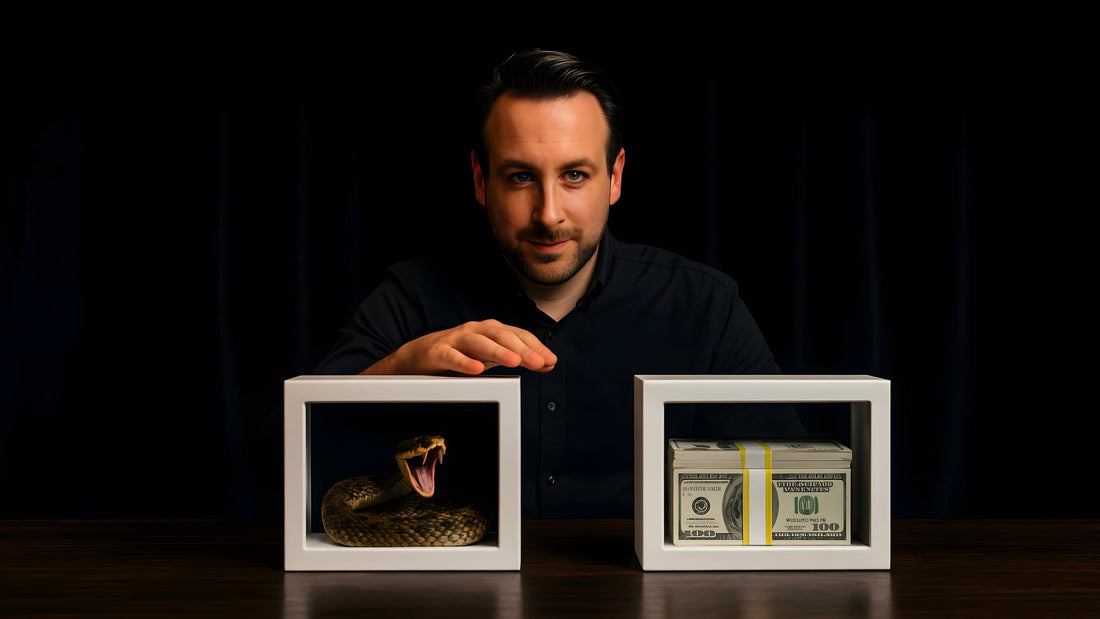
What's at stake?
I often perform an effect where I guess a number between 1 and 6. You can watch the routine here—first on Japanese TV, then in Manila:
The impact is strong, and yet it's just “1 out of 6”. Would the effect be stronger if I guessed one card out of 52? Is it possible to create the same—or even greater—impact with just a “1 out of 2” chance? The actor Gary Oldman offers us an answer:
(subtitles available in English and French)
Although this anecdote comes from the world of cinema, it deeply resonates with our field. An effect can be simple, the spectator may have few choices, but if the stakes are clearly expressed, the emotional impact can be huge. A strong effect is not measured by the number of available options, but by how the audience perceives the risk, the reward, or the consequence of an action.
Let’s take the classic example of “Smash and Stab”, where a mentalist smashes their hand down onto four paper cups, one of which hides a sharp spike. Mathematically, there are few choices (4) but the perceived danger is huge. And it's precisely this tension that fascinates. Everything relies on fear, adrenaline, and apparent risk. I described my own Russian roulette using eggs in the third book of my trilogy, "Your Mind Will Always Be My Playground".

The audience knows that the mentalist is in control. But part of them still doubts, still hopes, still clings to the emotional tension.
We can also think of the positive counterpart: the classic "Bank Night". This time, instead of risk, there’s a potential reward. A participant has a 1 in 4 chance of winning money.
Again, what matters isn’t the number of options—it’s what’s at stake: the fear of loss, or the hope of gain.
This principle also shows up in cinema. Take the Matrix saga, for example. In the first film, Neo faces Agent Smith one-on-one—a 1 in 2 chance to win and survive.
In the second film, Neo fights a hundred Smiths. The scene is visually impressive, and mathematically the threat is greater.
We might expect the third film to go even bigger—with a thousand Smiths or more. But instead, Neo faces just one single Smith again (while the clones stand in the background). And yet, the stakes are dramatically amplified: Neo is no longer fighting to save his life, but to save all of humanity.
In magic and mentalism, we too often present effects without stakes—and the audience risks disengaging. What makes a magical, theatrical, or cinematic moment truly memorable isn’t the number of options or the technical difficulty. It’s the perceived importance of the moment. Here are some ways to increase the stakes and tension for your audience.
First, let’s go back to Gary Oldman’s anecdote. We can modulate our performance—adjusting our pacing, our tone, and especially using silences. A pause just before a key decision or reveal increases the perceived gravity of the moment.
Second, we can use body language. If you’re relaxed during the whole routine but suddenly appear tense at the critical moment—with a fixed stare, hesitant hand, or shift in posture—you signal to the audience that “something important is about to happen.”
Third, involve the spectator—either physically (by making them participate), or narratively (by constructing a situation they can relate to). If the risk (or reward) directly affects them, they will be more invested. (And as a bonus, their success will be celebrated by the audience, creating a positive experience they’ll associate with you.)
Look at your repertoire and ask yourself: What’s at stake? How can I amplify or communicate it better? Your effects will become more compelling for the participant, the emotional impact will increase, and the experience will become more memorable for your audience.







